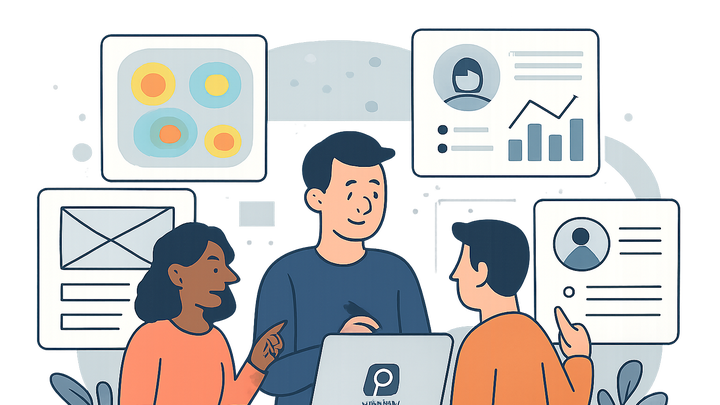Published on 2025-06-29T20:04:58Z
User-Centered Design: A Guide to Improving CRO, UX, and SEO
User-Centered Design (UCD) is a design framework that prioritizes the needs, behaviors, and feedback of end users at every stage of the design process. In the context of CRO, UX, and SEO, UCD ensures that websites not only look appealing but also perform effectively by aligning with real user expectations.
By grounding decisions in user research—such as surveys, usability tests, and analytics—designers can create interfaces that drive higher engagement, improve conversion rates, and increase search visibility. Tools like Prevue.me can augment the UCD process by providing actionable critiques for maximum lead generation, highlighting areas for UX improvements, accessibility compliance, and SEO optimizations.
Embracing UCD fosters a cycle of continuous feedback and iteration, ensuring that websites evolve alongside user needs and industry best practices.
From defining user personas and mapping user journeys to testing prototypes and measuring outcomes, UCD integrates both qualitative and quantitative methods. The result is a site architecture and interface that resonates with users, reduces friction, and converts casual visitors into loyal customers.
User-centered design
A design approach prioritizing user needs to boost UX, CRO, and SEO through iterative research, testing, and feedback.
Why User-Centered Design Matters
Understanding why UCD is critical for websites aiming to optimize conversions, improve SEO rankings, and deliver seamless UX.
-
Boosts conversion rate
By aligning designs with actual user expectations, UCD minimizes friction in the conversion funnel and increases lead generation.
-
Enhances user experience
UCD promotes intuitive navigation and satisfying interactions, resulting in higher engagement and retention.
-
Improves seo performance
Engaged users spend more time on site and interact with content, reducing bounce rate and signaling quality to search engines.
-
Ensures accessibility
By considering diverse user abilities and needs, UCD fosters inclusive design that meets accessibility standards.
Core Principles of User-Centered Design
The foundational pillars that guide UCD, ensuring a structured and user-focused approach.
-
User research
Collect qualitative and quantitative data through methods like interviews, surveys, and analytics to understand user behaviors and needs.
- Surveys:
Gather broad user opinions and preferences.
- Interviews:
Conduct in-depth conversations with representative users.
- Analytics:
Analyze behavioral data from tools like Google Analytics or prevue.me.
- Surveys:
-
Iterative design
Develop prototypes in cycles, testing and refining based on user feedback to gradually converge on the optimal solution.
- Wireframing:
Sketch low-fidelity layouts to test basic flows.
- Prototyping:
Create interactive models for deeper usability tests.
- A/b testing:
Compare design variants to determine user preferences.
- Wireframing:
-
Usability
Prioritize clarity, simplicity, and ease of use to reduce cognitive load and help users achieve their goals efficiently.
- Navigation:
Design clear menus and pathways.
- Feedback mechanisms:
Provide immediate responses to user actions.
- Error prevention:
Anticipate and mitigate user mistakes.
- Navigation:
Implementing UCD on Your Website
A step-by-step process for integrating UCD into your website development and optimization efforts.
-
Develop user personas
Create fictional representations of key audience segments based on research to guide design decisions.
- Demographics:
Age, location, job role, etc.
- Goals:
What users want to achieve on your site.
- Pain points:
Challenges users face that your site can solve.
- Demographics:
-
Map the user journey
Outline each stage a user goes through, identifying touchpoints and potential drop-off points.
- Awareness:
How users discover your site.
- Consideration:
What information they evaluate.
- Decision:
Actions leading to conversion.
- Retention:
Post-conversion engagement strategies.
- Awareness:
-
Conduct usability testing
Observe real users interacting with your site to uncover friction and usability issues.
- Moderated testing:
Facilitator guides the session and probes user thoughts.
- Unmoderated testing:
Users complete tasks independently via tools like prevue.me.
- Remote vs. in-person:
Choose the format that suits your resources and goals.
- Moderated testing:
Measuring and Optimizing with SaaS Tools
Leveraging specialized platforms to validate UCD efforts and uncover further optimization opportunities.
-
Prevue.me
Use prevue.me to receive actionable critiques tailored to CRO, UX, SEO, and accessibility, turning UCD insights into concrete website improvements.
- Automated heatmap analysis:
Visualize user attention and scrolling behavior.
- Conversion funnel reviews:
Identify drop-off points in critical user journeys.
- Accessibility audits:
Detect compliance issues and suggest fixes.
- Automated heatmap analysis:
-
Google analytics
Track user behavior patterns, conversion goals, and site performance to measure the impact of design changes.
- Behavior flow:
Visualize the path users take through your site.
- Goal completions:
Monitor conversion events.
- Bounce rate:
Assess initial user engagement.
- Behavior flow:
-
A/b testing platforms
Experiment with design variants to identify the most effective user experience elements.
- Optimizely:
Run targeted experiments on live traffic.
- Vwo:
Split test design versions and analyze results robustly.
- Optimizely:
